Transforming Spaces through the Power of Color in Interior Design
Color is more than just an aesthetic choice in interior design—it is a vital tool that shapes the mood, function, and personality of a space. An expertly chosen palette has the power to transform a room, influencing not just how it looks, but how it feels. Whether aiming for a tranquil retreat or an energizing workspace, the strategic use of color can turn ordinary interiors into inspiring environments that reflect personal style and serve practical needs. Unlocking the power of color opens the door to dramatic transformations, enabling designers and homeowners alike to create spaces that truly resonate.
The Psychological Impact of Color
Color and Mood
Colors have well-documented effects on mood, with each shade evoking specific emotional responses. Soft blues and gentle greens are often chosen for their calming qualities, promoting relaxation in bedrooms and living areas. Conversely, vibrant shades like reds, oranges, and yellows can create a sense of warmth, excitement, or friendliness, making them perfect for energetic spaces such as kitchens or social areas. The mood set by a room’s color palette flows into daily life, influencing productivity, comfort, and overall well-being. Understanding these dynamics allows designers to craft atmospheres that promote desired emotional outcomes, creating tailored environments for various activities and routines.
Influence on Perception
The perceptual effects of color go beyond mood, actively altering how we experience the dimensions and proportions of a room. Lighter colors can make a space feel larger and airier by maximizing light reflection, while darker tones can create intimacy by visually pulling walls closer together. Strategic application of contrasting or complementary colors can also draw attention to architectural features or create visual depth. Designers harness this knowledge to solve spatial challenges—turning cramped corners into inviting nooks, or transforming vast rooms into comfortable havens. Thoughtful use of color provides a powerful optical toolkit for making the most out of any interior.
Cultural and Personal Associations
Color perception is also deeply shaped by cultural background and individual preferences, which brings another layer of complexity to interior design. While white might symbolize purity and simplicity in some cultures, it can denote mourning in others. Personal history, tastes, and life experiences dictate how a homeowner responds to specific hues. Successful designers take time to understand these associations, creating interiors that respect cultural context and reflect personal style. By blending universal color psychology with individualized meaning, interiors become not just visually pleasing, but also truly resonant spaces.
Color as a Spatial Tool
In open-plan homes or multipurpose rooms, color becomes a silent architect, delineating distinct functional zones without the need for physical barriers. A subtle shift in wall hue or the bold accent of a painted ceiling can instantly demarcate a dining area from a lounge, or signal where a workspace begins in a shared environment. This approach creates visual order and enhances usability, supporting daily routines by making each area’s purpose clear at a glance. Thoughtful zone definition with color cultivates both order and fluidity, balancing aesthetic appeal with functional clarity.

Feature Walls and Statement Pieces
Feature walls allow for a concentrated burst of color without overwhelming the space. Choosing a single wall or architectural feature to highlight with an intense or contrasting shade injects personality and focus, transforming it into a visual anchor. Similarly, statement furniture or decor items in bold hues can serve as focal points, drawing attention and setting the tone for the room. These approaches are a powerful way to experiment with vibrant colors, offering flexibility to update or adjust the palette over time without a full redesign. The result is an evolving, vibrant environment that remains fresh and dynamic.
Layering and Texture
Color comes alive when paired with thoughtful layering and the interplay of textures. A monochromatic room, for example, springs to life when different shades of the same color are used across walls, textiles, and accessories, reinforced by varying finishes such as matte, gloss, and metallic. Layering permits subtle gradations and depth, making even restrained color schemes feel rich and dimensional. Textured surfaces, like rugs, curtains, and wall panels, can either intensify or soften the impact of a chosen hue. Mastering the balance of color and texture ensures the space feels engaging and inviting, never flat or monotonous.
Nature-Inspired Palettes
Drawing inspiration from the natural world offers a timeless approach to selecting interior colors. Earthy greens, sky blues, sandy beiges, and warm terracottas evoke serenity and organic harmony, forging a restorative connection with the outdoors. This approach works especially well in homes aiming for tranquility, grounding, or biophilic design. By mirroring the natural gradients and contrasts found in landscapes, designers can craft interiors that feel both sophisticated and comfortable, providing a sanctuary from urban hustle and daily stress. Nature-inspired palettes foster a sense of balance and wellness throughout any living space.
